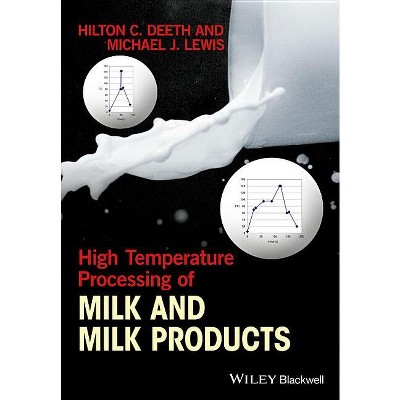Handbook of Fruits and Fruit Processing - 2nd Edition by Nirmal K Sinha & Jiwan Sidhu & Jozsef Barta & James Wu & M Pilar Cano (Hardcover)

About this item
Highlights
- HANDBOOK OF FRUITS AND FRUIT PROCESSING SECOND EDITION Fruits are botanically diverse, perishable, seasonal, and predominantly regional in production.
- About the Author: The Editors Nirmal K. Sinha, PhD, VP, Research and Development, Graceland Fruit Inc., Frankfort, Michigan, USA Jiwan S. Sidhu, PhD, Professor and Chairperson, Department of Family Sciences, College for Women, Kuwait University, Safat, Kuwait József Barta, PhD, Department Head and Vice Dean Scientific and International, Department of Food Science and Preservation, Corvinus University of Budapest, Hungary James S. B. Wu, PhD, Professor, Graduate Institute of Food Science and Technology, National Taiwan University, Taipei, Taiwan M. Pilar Cano, PhD, Professor, Institute of Food Research, Instituto de Investigación en Ciencias de la Alimentación, Madrid, Spain
- 720 Pages
- Technology, Food Science
Description
About the Book
"The processing of fruits continues to undergo rapid change. In the Handbook of Fruits and Fruit Processing, Second Edition, the editorial team has assembled over forty respected academicians and industry professionals from across the globe to create an indispensable resource on the scientific principles and technological methods for processing fruits of all types. Fruits are diverse and complex in production, storage, transport, packaging, processing and application. In a developed economy such as the United States approximately 60-70% fruits and vegetables are processed into various value added products and account for nearly a third of cash crop receipts and a fifth of agricultural exports. In emerging economies and markets there is an increasing emphasis on value added agriculture and realization about the nutritional aspects of fruits and vegetables.The second edition of the handbook on fruits and fruit processing further builds on the contents and quality of the first edition by incorporating contemporary and new scientific and technological developments that have occurred since its publication. The second edition improves, includes and expands the coverage of the subject matters to provide relevant developments in: horticultural biochemistry, microbiology (including HACCP, legal and safe microbial limits of fruit and fruit products entering world trade), sensory and flavor characteristics, nutrition, naturally present bioactive phenolics, postharvest physiology, storage, transportation and packaging, processing and preservation technologies (freezing, canning, aseptic processing, non-thermal technology, drying, etc.), and details on commodity processing including frozen fruits, canned fruit, jelly, jam and preserves, fruit juices, dried fruits and wines"--Book Synopsis
HANDBOOK OF FRUITS AND FRUIT PROCESSING
SECOND EDITION
Fruits are botanically diverse, perishable, seasonal, and predominantly regional in production. They come in many varieties, shapes, sizes, colors, flavors, and textures and are an important part of a healthy diet and the global economy. Besides vitamins, minerals, fibers, and other nutrients, fruits contain phenolic compounds that have pharmacological potential. Consumed as a part of a regular diet, these naturally occurring plant constituents are believed to provide a wide range of physiological benefits through their antioxidant, anti-allergic, anti-carcinogenic, and anti-inflammatory properties.
Handbook of Fruits and Fruit Processing distils the latest developments and research efforts in this field that are aimed at improving production methods, post-harvest storage and processing, safety, quality, and developing new processes and products. This revised and updated second edition expands and improves upon the coverage of the original book. Some highlights include chapters on the physiology and classification of fruits, horticultural biochemistry, microbiology and food safety (including HACCP, safety and the regulation of fruits in the global market), sensory and flavor characteristics, nutrition, naturally present bioactive phenolics, postharvest physiology, storage, transportation, and packaging, processing, and preservation technologies. Information on the major fruits includes tropical and super fruits, frozen fruits, canned fruit, jelly, jam and preserves, fruit juices, dried fruits, and wines. The 35 chapters are organized into five parts:
- Part I: Fruit physiology, biochemistry, microbiology, nutrition, and health
- Part II: Postharvest handling and preservation of fruits
- Part III: Product manufacturing and packaging
- Part IV: Processing plant, waste management, safety, and regulations
- Part V: Production, quality, and processing aspects of major fruits and fruit products
Every chapter has been contributed by professionals from around the globe representing academia, government institutions, and industry. The book is designed to be a valuable source and reference for scientists, product developers, students, and all professionals with an interest in this field.
From the Back Cover
HANDBOOK OF FRUITS AND FRUIT PROCESSING
SECOND EDITION
Fruits are botanically diverse, perishable, seasonal, and predominantly regional in production. They come in many varieties, shapes, sizes, colors, flavors, and textures and are an important part of a healthy diet and the global economy. Besides vitamins, minerals, fibers, and other nutrients, fruits contain phenolic compounds that have pharmacological potential. Consumed as a part of a regular diet, these naturally occurring plant constituents are believed to provide a wide range of physiological benefits through their antioxidant, anti-allergic, anti-carcinogenic, and anti-inflammatory properties.
Handbook of Fruits and Fruit Processing distils the latest developments and research efforts in this field that are aimed at improving production methods, post-harvest storage and processing, safety, quality, and developing new processes and products. This revised and updated second edition expands and improves upon the coverage of the original book. Some highlights include chapters on the physiology and classification of fruits, horticultural biochemistry, microbiology and food safety (including HACCP, safety and the regulation of fruits in the global market), sensory and flavor characteristics, nutrition, naturally present bioactive phenolics, postharvest physiology, storage, transportation, and packaging, processing, and preservation technologies. Information on the major fruits includes tropical and super fruits, frozen fruits, canned fruit, jelly, jam and preserves, fruit juices, dried fruits, and wines. The 35 chapters are organized into five parts:
- Part I: Fruit physiology, biochemistry, microbiology, nutrition, and health
- Part II: Postharvest handling and preservation of fruits
- Part III: Product manufacturing and packaging
- Part IV: Processing plant, waste management, safety, and regulations
- Part V: Production, quality, and processing aspects of major fruits and fruit products
Every chapter has been contributed by professionals from around the globe representing academia, government institutions, and industry. The book is designed to be a valuable source and reference for scientists, product developers, students, and all professionals with an interest in this field.
Review Quotes
"This "Handbook of Fruits and Fruit Processing" is a comprehensive description of the latest developments and research efforts in this special field that are aimed at improving production methods, post-harvest storage and processing, safety, quality as well as developing new processes and products." (Advances in Food Science, 1 January 2013)
About the Author
The Editors
Nirmal K. Sinha, PhD, VP, Research and Development, Graceland Fruit Inc., Frankfort, Michigan, USA
Jiwan S. Sidhu, PhD, Professor and Chairperson, Department of Family Sciences, College for Women, Kuwait University, Safat, Kuwait
József Barta, PhD, Department Head and Vice Dean Scientific and International, Department of Food Science and Preservation, Corvinus University of Budapest, Hungary
James S. B. Wu, PhD, Professor, Graduate Institute of Food Science and Technology, National Taiwan University, Taipei, Taiwan
M. Pilar Cano, PhD, Professor, Institute of Food Research, Instituto de Investigación en Ciencias de la Alimentación, Madrid, Spain











